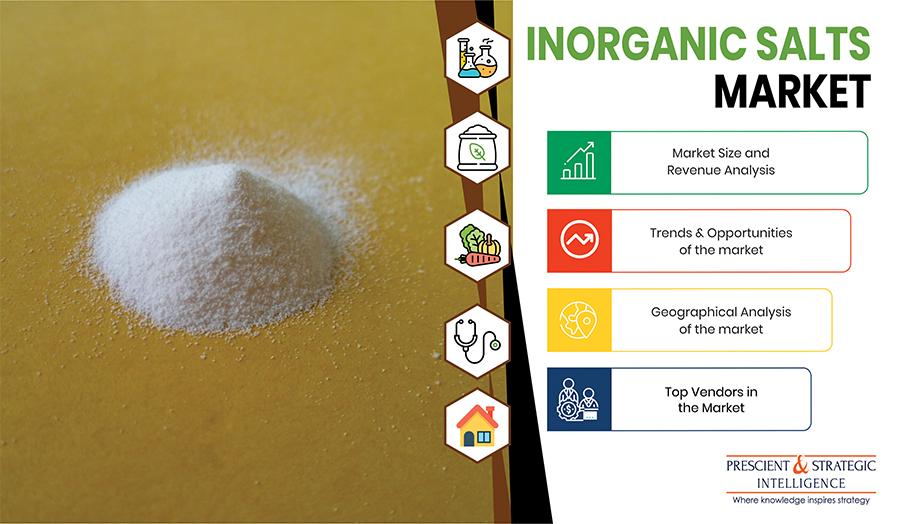𝐄𝐱𝐩𝐥𝐨𝐫𝐢𝐧𝐠 𝐭𝐡𝐞 𝐖𝐨𝐫𝐥𝐝 𝐨𝐟 𝐈𝐧𝐨𝐫𝐠𝐚𝐧𝐢𝐜 𝐒𝐚𝐥𝐭𝐬: 𝐍𝐚𝐭𝐮𝐫𝐞'𝐬 𝐄𝐬𝐬𝐞𝐧𝐭𝐢𝐚𝐥 𝐂𝐨𝐦𝐩𝐨𝐮𝐧𝐝𝐬
Inorganic salts play a pivotal position in various natural and commercial processes, serving as critical compounds that contribute to the general stability of lifestyles. Comprising an extensive variety of chemical combinations, inorganic salts are prevalent in our daily lives, from the food we devour to the water we drink.
The inorganic salts market size has been estimated at USD 188.6 Billion in 2023, and it will touch USD 290.8 Billion by 2030, propelling at a 6.5% compound annual growth rate during 2024–2030.
For more insights, check out the detailed report@ https://www.psmarketresearch.com/market-analysis/inorganic-salts-market
The Basics of Inorganic Salts:
Inorganic salts are compounds that result from the aggregate of positively charged ions (cations) and negatively charged ions (anions) through ionic bonding. Unlike natural salts, which contain carbon-hydrogen bonds, inorganic salts are without carbon-hydrogen bonds. This essential difference location of inorganic salts is one of the key constructing blocks of inorganic chemistry.
Diverse Types of Inorganic Salts:
The world of inorganic salts is huge and comprises a combination of compounds, each compound with unique features and workings. Common instances include sodium chloride (NaCl), potassium nitrate (KNO3), and calcium carbonate (CaCO3). Such salts are not only discovered in nature but also play critical roles in many industrial procedures.
Role in Biological Systems:
Inorganic salts are essential in biological systems, where they act as electrolytes, facilitating vital physiological capabilities. Sodium chloride, for example, performs an important role in maintaining the balance of fluids within the human body. Potassium chloride is important for nerve transmission and muscle contraction, underscoring the importance of inorganic salts in sustaining lifestyles. Inorganic salts are indispensable in biological systems, where they act as electrolytes, facilitating vital physiological functions.
Industrial Applications:
Inorganic salts have discovered enormous use in various industrial applications. Sodium chloride, generally referred to as table salt, isn't only a staple seasoning but also a vital aspect in various business approaches, inclusive of the production of chemical compounds and the remedy of wastewater. Calcium chloride is used in de-icing roads and as a desiccant in drying methods because of its hygroscopic nature.
Environmental Impact:
Inorganic salts have a profound effect on the environment. The immoderate use of fertilizers containing salts, inclusive of ammonium nitrate, can contribute to soil salinity, affecting plant increase and biodiversity. Additionally, the runoff of salts into water bodies can result in water pollution, highlighting the need for sustainable practices in the agricultural and industrial sectors.
Inorganic salts, with their varied properties and extensive applications, are essential to the working of biological systems and industrial procedures. From the microscopic realm of cellular functions to the macroscopic landscapes of agriculture and industry, these salts shape the world around us.
As we continue to discover and recognize the complex chemistry of inorganic salts, we attain insights into the delicate balance that withstands life and fuels technical improvements. Embracing a holistic perspective on these compounds permits us to gain their significance and encourages responsible practices to guarantee a harmonious coexistence with the environment.
Inorganic salts play a pivotal position in various natural and commercial processes, serving as critical compounds that contribute to the general stability of lifestyles. Comprising an extensive variety of chemical combinations, inorganic salts are prevalent in our daily lives, from the food we devour to the water we drink.
The inorganic salts market size has been estimated at USD 188.6 Billion in 2023, and it will touch USD 290.8 Billion by 2030, propelling at a 6.5% compound annual growth rate during 2024–2030.
For more insights, check out the detailed report@ https://www.psmarketresearch.com/market-analysis/inorganic-salts-market
The Basics of Inorganic Salts:
Inorganic salts are compounds that result from the aggregate of positively charged ions (cations) and negatively charged ions (anions) through ionic bonding. Unlike natural salts, which contain carbon-hydrogen bonds, inorganic salts are without carbon-hydrogen bonds. This essential difference location of inorganic salts is one of the key constructing blocks of inorganic chemistry.
Diverse Types of Inorganic Salts:
The world of inorganic salts is huge and comprises a combination of compounds, each compound with unique features and workings. Common instances include sodium chloride (NaCl), potassium nitrate (KNO3), and calcium carbonate (CaCO3). Such salts are not only discovered in nature but also play critical roles in many industrial procedures.
Role in Biological Systems:
Inorganic salts are essential in biological systems, where they act as electrolytes, facilitating vital physiological capabilities. Sodium chloride, for example, performs an important role in maintaining the balance of fluids within the human body. Potassium chloride is important for nerve transmission and muscle contraction, underscoring the importance of inorganic salts in sustaining lifestyles. Inorganic salts are indispensable in biological systems, where they act as electrolytes, facilitating vital physiological functions.
Industrial Applications:
Inorganic salts have discovered enormous use in various industrial applications. Sodium chloride, generally referred to as table salt, isn't only a staple seasoning but also a vital aspect in various business approaches, inclusive of the production of chemical compounds and the remedy of wastewater. Calcium chloride is used in de-icing roads and as a desiccant in drying methods because of its hygroscopic nature.
Environmental Impact:
Inorganic salts have a profound effect on the environment. The immoderate use of fertilizers containing salts, inclusive of ammonium nitrate, can contribute to soil salinity, affecting plant increase and biodiversity. Additionally, the runoff of salts into water bodies can result in water pollution, highlighting the need for sustainable practices in the agricultural and industrial sectors.
Inorganic salts, with their varied properties and extensive applications, are essential to the working of biological systems and industrial procedures. From the microscopic realm of cellular functions to the macroscopic landscapes of agriculture and industry, these salts shape the world around us.
As we continue to discover and recognize the complex chemistry of inorganic salts, we attain insights into the delicate balance that withstands life and fuels technical improvements. Embracing a holistic perspective on these compounds permits us to gain their significance and encourages responsible practices to guarantee a harmonious coexistence with the environment.
1
0 Reacties
0 Aandelen
